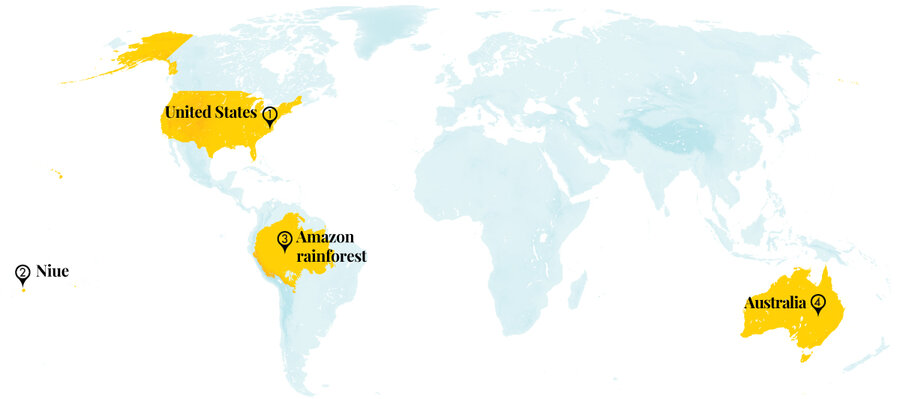Care strategies: Every animal in a rainforest, every wave of an ocean
Loading...
At at U.S. farm where women work after release from prison, the care strategy is a wraparound approach to moving forward. And in environment news, a giant Amazon photo album may help the rainforest, while the island of Niue is protecting 100% of its marine environment.
1. United States
Women in North Carolina are rebuilding their lives after prison with local support. The nonprofit Benevolence Farm welcomes six formerly incarcerated women at a time to live for free on 13 acres in a shared home for up to two years. There, they earn at least $15 an hour by working on the farm or making artisanal candles and body care products to sell online, and they have access to services like career-building courses, transportation, and health appointments.
Given high recidivism rates and rising incarceration rates in rural counties, the farm offers valuable lessons for other reentry programs. The impact is relatively small – 32 individuals have been through the program since it began in 2008 – but 84% of those residents continue living freely, most of them in the surrounding county, according to a 2020 annual report. Participants tout its effectiveness: “Even in my darkest moments, these women were ready to receive my call,” said one of the program participants, Katie Anderson. “They literally saved my life. And not only that, they helped me rebuild a relationship with my children.”
Source: Southerly
2. Niue
The Pacific island of Niue has committed to legally protecting 100% of its ocean. The tiny island is home to only 1,700 people, but the 317,500 square kilometers of sovereign waters around one of the world’s largest raised coral atolls include numerous underwater caves, spinner dolphins, and gray reef sharks. The newly designated Niue Nukutuluea marine park is divided into separate zones for research, recreation, conservation, and fishing; violators of the new laws will face fines of up to $500,000 (New Zealand; U.S.$320,000) or further prosecution. “The ocean is everything to us,” said Niuean Premier Dalton Tagelagi. “It’s what defines us.”
Over 50 countries have pledged to help conserve 30% of the world’s oceans by 2030, though only 6% of the waters have so far received protected status. Critics of the strategy point out that fishers can simply move to other waters, and enforcement can be a challenge in these isolated areas. Without a navy of its own, Niue relies on neighboring countries like Tonga, Samoa, the Cook Islands, and New Zealand to watch for illegal fishing. Locals will also monitor the areas, with satellite surveillance help from nonprofit organization Global Fishing Watch.
Sources: The Guardian, EcoWatch
3. Amazon rainforest
The largest-ever photo database of Amazon wildlife is making it easier to monitor biodiversity and habitat loss. Scientists often use camouflaged, motion-sensor cameras known as camera traps to study animals that are good at hiding from humans. Researchers have now compiled and standardized over 154,000 of these images, documenting 317 species of birds, mammals, and reptiles across Brazil, Bolivia, Colombia, Ecuador, French Guiana, Peru, Suriname, and Venezuela.
The new study assembles records from scientists at 122 research institutions around the world, spearheaded by the German Centre for Integrative Biodiversity Research and Friedrich Schiller University Jena. With access to the photos, researchers will be able to better “understand the patterns of species distribution in their habitats, interaction between predator and prey species, as well as make future projections about the impact of climate and land-use change for the species,” said Ana Carolina Antunes, lead author of the paper, in an email to Mongabay. “There is still so much to learn.”
Source: Mongabay
4. Australia
Australia’s new government is its most diverse yet. Women now hold 45% of ministry positions, including a record 10 out of 23 highest-ranking posts, progress that comes following a series of sexual misconduct scandals in the previous administration. Among the new ministers are Linda Burney, the first Aboriginal woman to serve as minister for Indigenous Australians, and Foreign Affairs Minister Penny Wong, who was born in Malaysia and is openly gay.
With an estimated 21% of the Australian population from non-European backgrounds, but only 6% of members of Parliament, the country has a long way to go when it comes to representation. For newly elected MP Sally Sitou, whose parents emigrated from Laos and who has Chinese heritage, growing political diversity implies better leadership: “You bring different experiences and perspectives, different ways of looking at the world, and that is what’s going to make our parliament stronger and our democracy stronger.”
Source:Global Citizen








